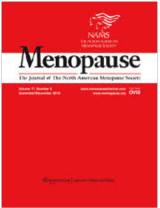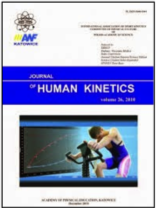Nordic walking increases circulating VEGF more than traditional walking training in postmenopause
Link: http://www.tandfonline.com/doi/full/10.1080/13697137.2017.1366979
References:
Stojanovska L, Apostolopoulos V, Polman R, Borkoles E. To exercise, or, not to exercise, during menopause and beyond. Maturitas 2014;77:318–23[Crossref], [PubMed], [Web of Science ®], [Google Scholar]
Di Blasio A, Bucci I, Ripari P, et al. Lifestyle and high density lipoprotein cholesterol in postmenopause. Climacteric 2014;17:37–47[Taylor & Francis Online], [Web of Science ®], [Google Scholar]
Di Blasio A, Izzicupo P, D’Angelo E, et al. Effects of patterns of walking training on metabolic health of untrained postmenopausal women. J Aging Phys Act 2014;22:482–9[Crossref], [PubMed], [Web of Science ®], [Google Scholar]
Corrick KL, Hunter GR, Fisher G, Glasser SP. Changes in vascular hemodynamics in older women following 16 weeks of combined aerobic and resistance training. J Clin Hypertens 2013;15:241–6[Crossref], [Web of Science ®], [Google Scholar]
Gallina S, Di Francescomarino S, Di Mauro M, et al. NAD(P)H oxidase p22(phox) polymorphism and cardiovascular function in amateur runners. Acta Physiol (Oxf) 2012;206:20–8[Crossref], [PubMed], [Web of Science ®], [Google Scholar]
Izzicupo P, Ghinassi B, D’Amico MA, et al. Effects of ACE I/D polymorphism and aerobic training on the immune-endocrine network and cardiovascular parameters of postmenopausal women. J Clin Endocrinol Metab 2013;98:4187–94[Crossref], [PubMed], [Web of Science ®], [Google Scholar]
Izzicupo P, D’Amico MA, Bascelli A, et al. Walking training affects dehydroepiandrosterone sulfate and inflammation independent of changes in spontaneous physical activity. Menopause 2013;20:455–63[PubMed], [Web of Science ®], [Google Scholar]
Pellegrini B, Peyré-Tartaruga LA, Zoppirolli C, et al. Exploring muscle activation during nordic walking: a comparison between conventional and uphill walking. PLoS One 2015;10:e0138906[Crossref], [PubMed], [Web of Science ®], [Google Scholar]
Kukkonen-Harjula K, Hiilloskorpi H, Mänttäri A, et al. Self-guided brisk walking training with or without poles: a randomized-controlled trial in middle-aged women. Scand J Med Sci Sports 2007;17:316–23[PubMed], [Web of Science ®], [Google Scholar]
Hagner-Derengowska M, Kałużny K, Kochański B, et al. Effects of nordic walking and pilates exercise programs on blood glucose and lipid profile in overweight and obese postmenopausal women in an experimental, nonrandomized, open-label, prospective controlled trial. Menopause 2015;22:1215–23[Crossref], [PubMed], [Web of Science ®], [Google Scholar]
Wagenmakers AJ, Strauss JA, Sherpherd SO, Keske MA, Cocks M. Increased muscle blood supply and transendothelial nutrient and insulin transport induced by food intake and exercise: effect of obesity and ageing. J Physiol 2016;594:2207–22[Crossref], [PubMed], [Web of Science ®], [Google Scholar]
dela Paz NG, Walshe TE, Leach LL, Saint-Geniez M, D’Amore PA. Role of shear-stress-induced VEGF expression in endothelial cell survival. J Cell Sci 2012;15:831–43[Crossref], [Google Scholar]
Leung D, Cachianes G, Kuang W, Goeddel D, Ferrara N. Vascular endothelial growth factor is a secreted angiogenic mitogen. Science 1989;246:1306–9[Crossref], [PubMed], [Web of Science ®], [Google Scholar]
Hoier B, Hellsten Y. Exercise-induced capillary growth in human skeletal muscle and the dynamics of VEGF. Microcirculation 2014;21:301–14[Crossref], [PubMed], [Web of Science ®], [Google Scholar]
Wahl P, Jansen F, Achtzehn S, et al. Effects of high intensity training and high volume training on endothelial microparticles and angiogenic growth factors. PLoS One 2014;9:e96024[Crossref], [PubMed], [Web of Science ®], [Google Scholar]
Wahl P, Zinner C, Achtzehn S, Behringer M, Bloch W, Mester J. Effects of acid-base balance and high or low intensity exercise on VEGF and bFGF. Eur J Appl Physiol 2011;111:1405–13[Crossref], [PubMed], [Web of Science ®], [Google Scholar]
Suhr F, Brixius K, de Marees M, et al. Effects of short-term vibration and hypoxia during high-intensity cycling exercise on circulating levels of angiogenic regulators in humans. J Appl Physiol 2007;103:474–83[Crossref], [PubMed], [Web of Science ®], [Google Scholar]
Hoier B, Rufener N, Bojsen-Møller J, Bangsbo J, Hellsten Y. The effect of passive movement training on angiogenic factors and capillary growth in human skeletal muscle. J Physiol 2010;1:3833–45[Crossref], [Google Scholar]
Hellsten Y, Rufener N, Nielsen JJ, Hoier B, Krustrup P, Bangsbo J. Passive leg movement enhances interstitial VEGF protein, endothelial cell proliferation, and eNOS mRNA content in human skeletal muscle. Am J Physiol Regul Integr Comp Physiol 2008;294:R975–82[Crossref], [PubMed], [Web of Science ®], [Google Scholar]
Prior BM, Yang HT, Terjung RL. What makes vessels grow with exercise training?. J Appl Physiol 2004;97:1119–28[Crossref], [PubMed], [Web of Science ®], [Google Scholar]
McArthur D, Dumas A, Woodend K, Beach S, Stacey D. Factors influencing adherence to regular exercise in middle-aged women: a qualitative study to inform clinical practice. BMC Womens Health 2014;14:49[Crossref], [PubMed], [Web of Science ®], [Google Scholar]
Goossens GH, Bizzarri A, Venteclef N, et al. Increased adipose tissue oxygen tension in obese compared with lean men is accompanied by insulin resistance, impaired adipose tissue capillarization, and inflammation. Circulation 2011;124:67–76[Crossref], [PubMed], [Web of Science ®], [Google Scholar]
Stewart A, Marfell-Jones M, Ods T, De Ridder H, International Standards for Anthropometric Assessment. 3rd ed. Lower Hutt (NZ): International Society for the Advancement of Kinanthropometry; 2011. p. 57–88 [Google Scholar]
ACSM. ACSM Guidelines for Exercise Testing and Prescription. 6th ed. Baltimore (MD): Lippincott Williams & Wilkins; 2000. p. 61–99 [Google Scholar]
Mayers A, Multivariate analyses. In: Introduction to Statistics and SPSS in Psychology, 1st ed. Harlow: Pearson; 2013 [Google Scholar]
World Health Organization. Waist circumference and waist–hip ratio: Report of a WHO expert consultation. Geneva: World Health Organization; 2008 [Google Scholar]
NHLBI Obesity Education Initiative. The Practical Guide: Identification, Evaluation and Treatment of Overweight and Obesity in Adults. National Institutes of Health (NIH Publication Number 00‐4084), 2000 [Google Scholar]
Hiscock N, Fischer CP, Pilegaard H, Pedersen BK. Vascular endothelial growth factor mRNA expression and arteriovenous balance in response to prolonged, submaximal exercise in humans. Am J Physiol Heart Circ Physiol 2003;285:H1759–63[Crossref], [PubMed], [Web of Science ®], [Google Scholar]
Padilla J, Simmons GH, Bender SB, Arce-Esquivel AA, Whyte JJ, Laughlin MH. Vascular effects of exercise: endothelial adaptations beyond active muscle beds. Physiology (Bethesda) 2011;26:132–45[Crossref], [PubMed], [Web of Science ®], [Google Scholar]
Adams V, Linke A, Breuckmann F, et al. Circulating progenitor cells decrease immediately after marathon race in advanced-age marathon runners. Eur J Cardiovasc Prev Rehabil 2008;15:602–7[Crossref], [PubMed], [Google Scholar]
Gu JW, Gadonski G, Wang J, Makey I, Adair TH. Exercise increases endostatin in circulation of healthy volunteers. BMC Physiol 2004;16:4 [Google Scholar]
Febbraio MA, Pedersen BK. Muscle-derived interleukin-6: mechanisms for activation and possible biological roles. Faseb J 2002;16:1335–47[Crossref], [PubMed], [Web of Science ®], [Google Scholar]
Miyazawa-Hoshimoto S, Takahashi K, Bujo H, Hashimoto N, Saito Y. Elevated serum vascular endothelial growth factor is associated with visceral fat accumulation in human obese subjects. Diabetologia 2003;46:1483–8[Crossref], [PubMed], [Web of Science ®], [Google Scholar]
Seida A, Wada J, Kunitomi M, et al. Serum bFGF levels are reduced in Japanese overweight men and restored by a 6-month exercise education. Int J Obes Relat Metab Disord 2003;27:1325–31[Crossref], [PubMed], [Web of Science ®], [Google Scholar]
Figard-Fabre H, Fabre N, Leonardi A, Schena F. Efficacy of Nordic walking in obesity management. Int J Sports Med 2011;32:407–14[Crossref], [PubMed], [Web of Science ®], [Google Scholar]
Zenko Z, Ekkekakis P, Ariely D. Can you have your vigorous exercise and enjoy it too? Ramping intensity down increases postexercise, remembered, and forecasted pleasure. J Sport Exerc Psychol 2016;38:149–59[Crossref], [PubMed], [Web of Science ®], [Google Scholar]
Di Blasio A, Morano T, Napolitano G, et al. Nordic walking and the Isa method for breast cancer survivors: effects on upper limb circumferences and total body extracellular water – a pilot study. Breast Care (Basel) 2016;11:428–31[Crossref], [PubMed], [Web of Science ®], [Google Scholar]

Link: http://www.ncbi.nlm.nih.gov/pubmed/25803666
Reference:
Hagner-Derengowska M, Kałużny K, Kochański B, et al. (2015) ‘Effects of Nordic Walking and Pilates exercise programs on blood glucose and lipid profile in overweight and obese postmenopausal women in an experimental, nonrandomized, open-label, prospective controlled trial’, Menopause [Epub ahead of print].

Reference:
Hagner, W., Hagner-Derengowska, M., Wiacek, M., & Zubrzycki, I. Z. (2009). Changes in level of V˙ O2max, blood lipids, and waist circumference in the response to moderate endurance training as a function of ovarian aging. Menopause, 16(5), 1009-1013.

Link: http://www.johk.pl/files/26zubrzycki.pdf
Reference:
Trabka, B., Zubrzycki, I. Z., Ossowski, Z., Bojke, O., Clarke, A., Wiacek, M., & Latosik, E. (2014). Effect of a MAST Exercise Program on Anthropometric Parameters, Physical Fitness, and Serum Lipid Levels in Obese Postmenopausal Women. Journal of Human Kinetics, 42(1), 149-155.
